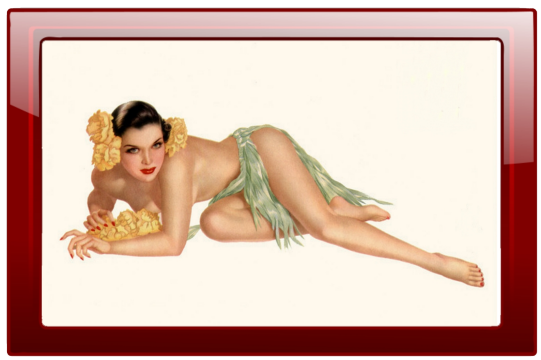
Early Hawaiian Kitsch (circa 1825): Our coming to reside on shore has been the signal for all the petty traffickers in curiosities to gather round us. Feather tippets and cloaks, war-helmets, weapons, mother-of-pearl fish-hooks, and even
gods are brought to market; and as the latter article has been in much demand, the handicraftsmen have set to work and manufactured a few new ones, just as good as the old, but that they have never been worshipped. And do not the antiquemakers
in Rome do the same?
[From the journal of Lord Byron's voyage on the Blonde, 1822-1825]
[From the journal of Lord Byron's voyage on the Blonde, 1822-1825]
While the allure of the floating treasure chests made Native Hawaiians complicit, aided by foreign diseases, in the changes that would be directed on their
people and islands by missionaries and business interests, it was those foreign groups' arrogant dismissal of nearly all things Hawaiian which orchestrated
the events. In a joint resolution, the US Congress in 1993 apologized to Native Hawaiians on behalf of the United States for the overthrow of the Kingdom of
Hawaii, but offered no restitution of any kind to Native Hawaiians who are now a meager 6% of the population on their islands.
Making our own mark and effectuating change along the way is all well and good until we have reason to lament the past that is no longer. Besides, no
culture is immutable. When one culture encounters another, it may choose to prop up barricades and fight to remain unchanged or confidently accept
influences from outside. The changes in Native Hawaiian culture on the islands have, of course, been fundamental but the culture lives on in remnants, ashes
floating in the air after the funeral pyre has gone out-- now fostered interestingly enough by the tourism industry.
Long before the aloha shirt, Native Hawaiians were marketing items of their former culture. They must have known that tourism was the only sustainable
industry for the small island group in the middle of the Pacific Ocean. Hawai'i has already been a state for over 50 years. Most of the flowers and birds which
make the flora and fauna of the islands so beautiful are transplants, some originating perhaps from the Spaniard Marin as Chamisso had recorded in 1817;
the native species are often endangered similarly to the Native Hawaiians and their culture. Whites are the dominant group, now in numbers as well as
politically. While ethnic Japanese had numbered slightly higher than the whites as late as 1960, they are now but a half the size in population. Ethnic
Filipinos, who surged in immigration beginning in the late 1960s, are now a slightly larger group though Japanese remain important particularly because their
social and economic ties to Japan remain strong, and Japanese tourism and investment in Hawai'i is high.
Just as Hiram Bingham had predicted, surfing all but disappeared as Native Hawaiians adopted Western dress, but was revived with the introduction of the
swimsuit. A group of teenage Hawaiian boys who surfed at Waikiki formed one of the first surf clubs which they called Hui Nalu (Club of Waves). In the Early
Hawaiian tradition, one of the members of Hui Nalu, Duke Kahanamoku, was also a great swimmer, winning gold medals in the 1912 and 1920 Olympics. As
an Olympic champion, he became an ambassador for surfing, first in Australia, then in Southern California where he worked for a while as an actor. As a
teenager, Kahanamoku rode a traditional 16-foot long, 114 pound, koa-wood board he called "papa nui". The board didn't have a skeg, which was invented in
the mid-1930s. He would later ride smaller boards, but always made from wood. Kahanamoku then helped make surfing an international sport, but despite its
modern popularity, it is still not as important to any one group as it once was to the Early Hawaiians.
English and Japanese are the most common languages you will hear in Hawai'i. To the average tourist, the Hawaiian language is dead except for a handful
of words they may encounter like aloha, mahalo and poi, but the language has survived and shows signs of strengthening. The more than 5000 individual
phrases broadcast on The Bus, include Native Hawaiian names and words, enunciated by an associate professor at the University of Hawaii's Kawaihuelani
Center for Hawaiian Language. More substantively, the k-12 Kamehameha Schools established by Bernice Pauahi Bishop, which are largely restricted to
students of Native Hawaiian descent, emphasize Hawaiian language and culture. The Hawaiian language continues to be taught at the University of Hawai'i,
and through hula as well though the costumes have been modified over time due to changing social conventions regarding modesty while alternative
materials are now used as a convenience.
Newspapers provide one avenue for a community to maintain its identity. Gibson's paper, the Pacific Commercial Advertiser, changed hands several times
after he was pushed out of Hawai'i. It was owned for a period by Claus Spreckels and was eventually sold to Lorrin Thurston whose family continued to own
the paper, which they renamed the Honolulu Advertiser. Under the Thurston family, the paper was a stridently pro-business voice of the Big Five until the
1960s when it switched its loyalties to new immigrants and the multiethnic descendants of the plantation workers with a progressive political viewpoint. The
Thurston family sold the paper in 1992.
When I lived in Hawai'i, the Honolulu Advertiser (now the Honolulu Star-Advertiser after merging with the Star-Bulletin in 2010) was a font of information
about all things Hawaiian whether it be an investigative article about the enormous revenues of the Mormon Church-owned Polynesian Cultural Center on
O'ahu, the prostitution businesses which predominated in Chinatown for the US servicemen stationed in Honolulu prior to WWII to those run out of
barbershops on Keeaumoku Street straddling Makiki and Ala Moana, or more mundane, everyday events.